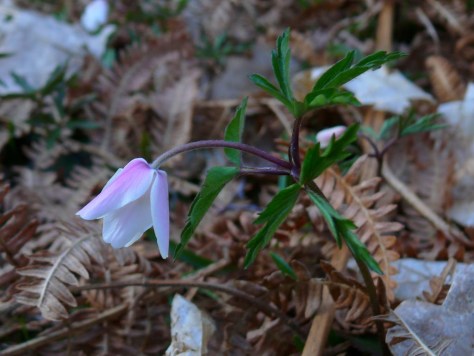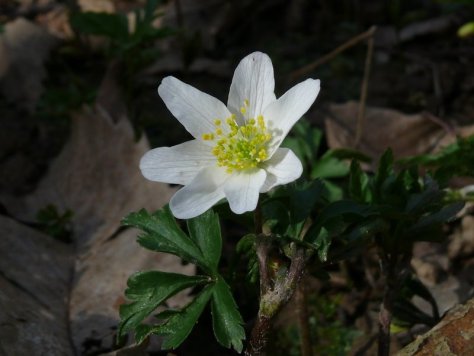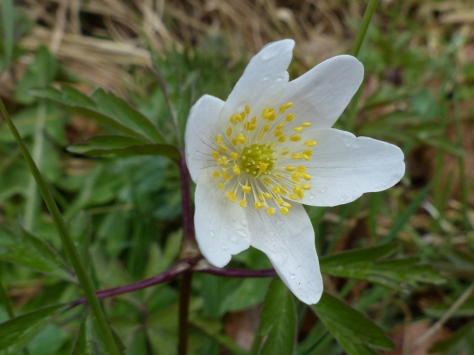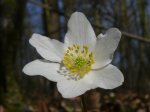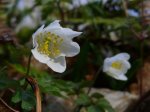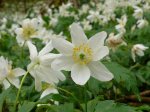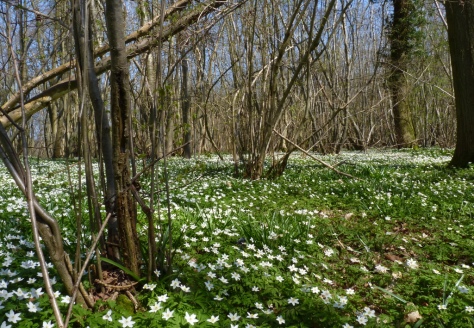Smell Fox is another name for the Wood Anemone and we will have more of them later, also a smelly Fox. First let me show you Fizz’s latest masterpiece.
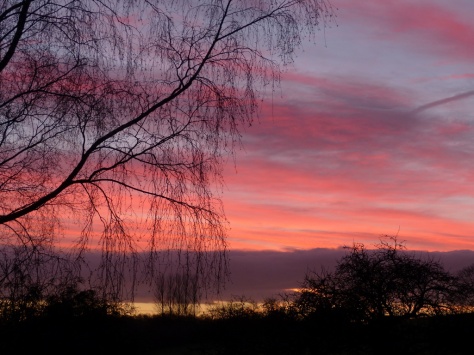 She called this, “The Sky in his Pyjamas” and it was taken at dawn yesterday.
She called this, “The Sky in his Pyjamas” and it was taken at dawn yesterday.
This is a video of a smelly Fox.
We have finished our Wild Boar hunt having got what we went after.
We picked up the camera yesterday with seventy five videos on the card and I really expected seventy five videos of a Fox eating until it popped but no…
We had about fifteen videos of the Fallow Deer.
Then we got this.
Let me just tell you what you are going to see, it is not very clear. If you are very quick you may see two Deer running in front of the Boar and triggering the camera, they are only in shot for about a second, then three female Boar walk through the wood in front of the camera. They don’t come into the light unfortunately but it is clear to me that they are Boar.
Why stop there? Well we haven’t exactly stopped, there is good reason to go back and I will tell you about that in a minute, we are just taking a break.
These animals are not safe!
I won’t endanger an animal for the sake of a photograph. There are not a lot of Wild Boar around here, they are being shot and that shooting is causing them to disperse and try and find safe places to live but it is a precarious existence.
Boar meat fetches about £6.50 a kilo (unbutchered) and about 70% of a Boar is meat. The average weight of a female is between 80 -120 kilos. To a shooter a little one (50 kg) is worth about £200. Some people are very, very keen to learn the locations of these animals.
There are no laws to protect these animals. With the landowners permission and the relevant gun licence anyone can shoot any boar at any time with anything they can lay their hands on. They are not safe.
We will go back because these animals will give birth in the spring, between them they could have twenty hoglets. They will live in a group called a sounder and the mothers can suckle each others young. If anything happens to one mother the others will take care of her hoglets. Infant mortality is about 50% in the first month so many of the little ones won’t make it but those that do will stay with the group for at least four months maybe the whole year. Despite any garbage that you may read to the contrary, Wild Boar have just one litter a year.
It would be nice to see some of this, don’t you think?
Enough Boar hunting for now, what about the pesky Sheep.
The Sheep are back in the fields but I don’t know for how long. We found two stuck in the hedge this morning.
 Fizz found herself stuck in the hedge while I went to free the sheep…
Fizz found herself stuck in the hedge while I went to free the sheep…
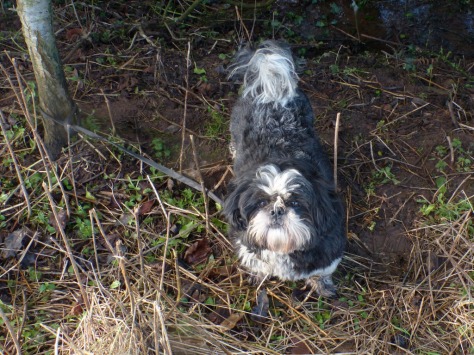 and the sheep took off carrying half of the hedge with them.
and the sheep took off carrying half of the hedge with them.
 We are going to have to go and catch this Sheep and clean it up a bit, it looks camouflaged.
We are going to have to go and catch this Sheep and clean it up a bit, it looks camouflaged.
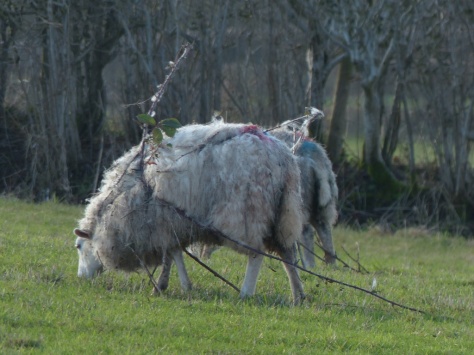 After a couple of hours of chasing Sheep around the field, I remembered that I had stuck Fizz in the hedge and I went back and got her. She was none the worse for it.
After a couple of hours of chasing Sheep around the field, I remembered that I had stuck Fizz in the hedge and I went back and got her. She was none the worse for it.
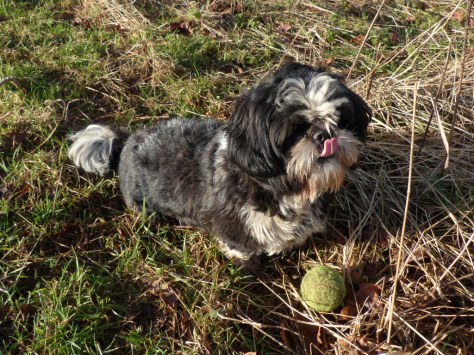 So, Smell Fox, the Wood Anemone flower doesn’t have any noticeable scent but the leaves smell musty, like a Fox.
So, Smell Fox, the Wood Anemone flower doesn’t have any noticeable scent but the leaves smell musty, like a Fox.
Anemone nemorosa, The Wood Anemone
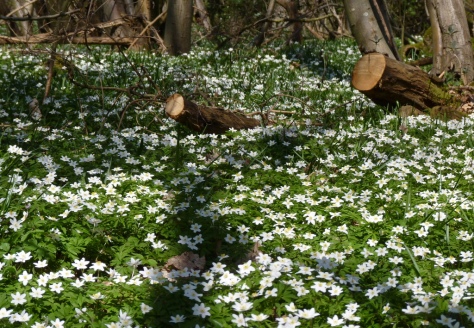 Greek legend has it that Anemos (The God of Wind) sent Anemones in the springtime to tell of his coming. An old name for this flower is Windflower, Pliny the Elder (Roman author of Naturalis Historia) wrote that “The flowers do not open unless the wind blows.” He was wrong. The flowers do not open unless the sun shines.
Greek legend has it that Anemos (The God of Wind) sent Anemones in the springtime to tell of his coming. An old name for this flower is Windflower, Pliny the Elder (Roman author of Naturalis Historia) wrote that “The flowers do not open unless the wind blows.” He was wrong. The flowers do not open unless the sun shines.
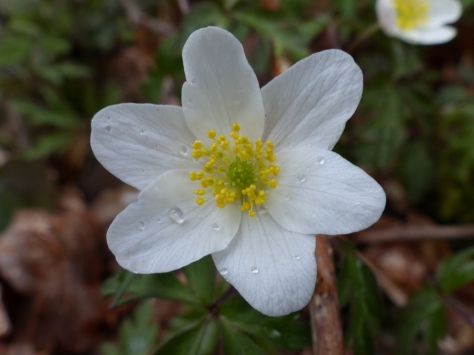
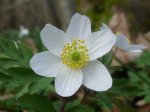
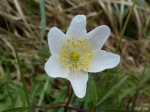
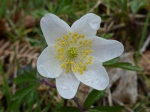 The Wood Anemone is an early spring flower. It usually flowers in March and lasts until the Bluebells are ready to flower in April.
The Wood Anemone is an early spring flower. It usually flowers in March and lasts until the Bluebells are ready to flower in April.
The little wood that I used to own was both a Bluebell wood and an Anemone wood. The flowers grew through each other and in March the forest floor was white with little to show of the Bluebell display that was soon to follow.
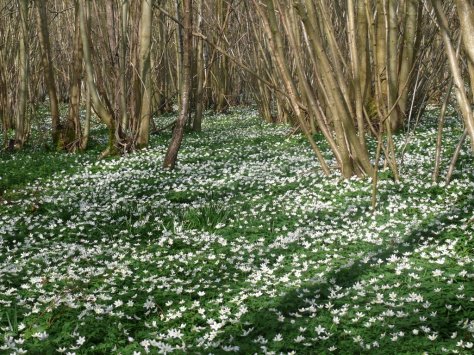 The Wood Anemone is an animated flower, it closes at night.
The Wood Anemone is an animated flower, it closes at night.
 It opens in the morning when it feels the warmth and then it twists and turns throughout the day to follow the sun. It is a wonderful thing to spend a day in such a wood watching the movement of the flowers.
It opens in the morning when it feels the warmth and then it twists and turns throughout the day to follow the sun. It is a wonderful thing to spend a day in such a wood watching the movement of the flowers.
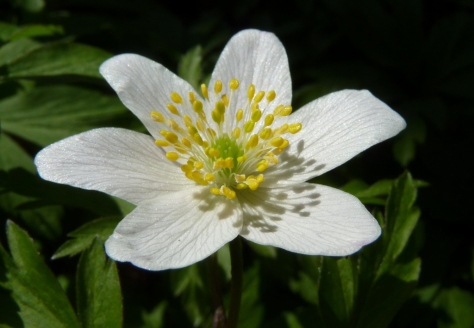 The flower has no petals, it generally has six or seven, white sepals but sometimes as many as ten. It has multiple stamens.
The flower has no petals, it generally has six or seven, white sepals but sometimes as many as ten. It has multiple stamens.
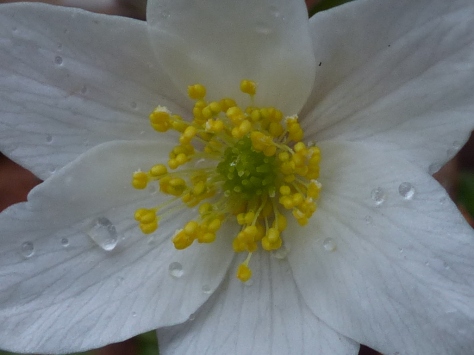 The leaves are divided into three deeply lobed and toothed leaflets.
The leaves are divided into three deeply lobed and toothed leaflets.
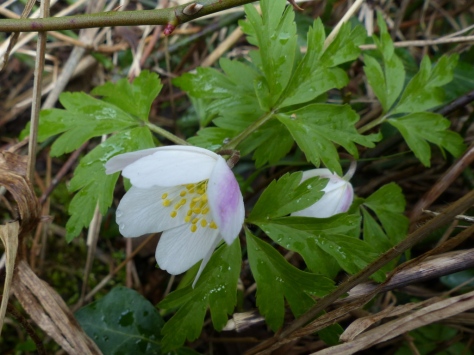 Nectar: You will read on a lot of web sites that the Wood Anemone does not produce nectar when in fact it does. The reason for this confusion is simply because it was only proven in 2013 when scientists published a paper in the Journal, “Organisms Diversity and Evolution” (September 2013) They observed the Large Bee Fly (Bombylius major) nectaring on Anemone nemorosa and discovered that the flower does indeed have nectaries deep within the corolla. The large Bee Fly has a very long tongue.
Nectar: You will read on a lot of web sites that the Wood Anemone does not produce nectar when in fact it does. The reason for this confusion is simply because it was only proven in 2013 when scientists published a paper in the Journal, “Organisms Diversity and Evolution” (September 2013) They observed the Large Bee Fly (Bombylius major) nectaring on Anemone nemorosa and discovered that the flower does indeed have nectaries deep within the corolla. The large Bee Fly has a very long tongue.
Many websites will not have updated that information and so confusion reigns on the internet, as always. Anyway nothing has changed if you have a short tongue.
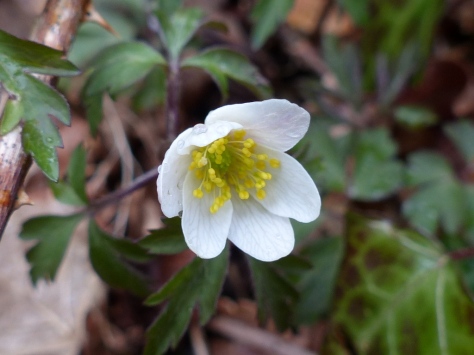 Pollination and seed production are not essential to the Wood Anemone, in fact, I read that most of the seed produced is sterile. The plant spreads from it’s roots (rhizomes). Unlike the Bluebell it can spread very rapidly to colonise a wood.
Pollination and seed production are not essential to the Wood Anemone, in fact, I read that most of the seed produced is sterile. The plant spreads from it’s roots (rhizomes). Unlike the Bluebell it can spread very rapidly to colonise a wood.
Kingdom: Plantae
Order: Ranunculales
Family: Ranunculaceae
Genus: Anemone
Species: Anemone nemorosa

